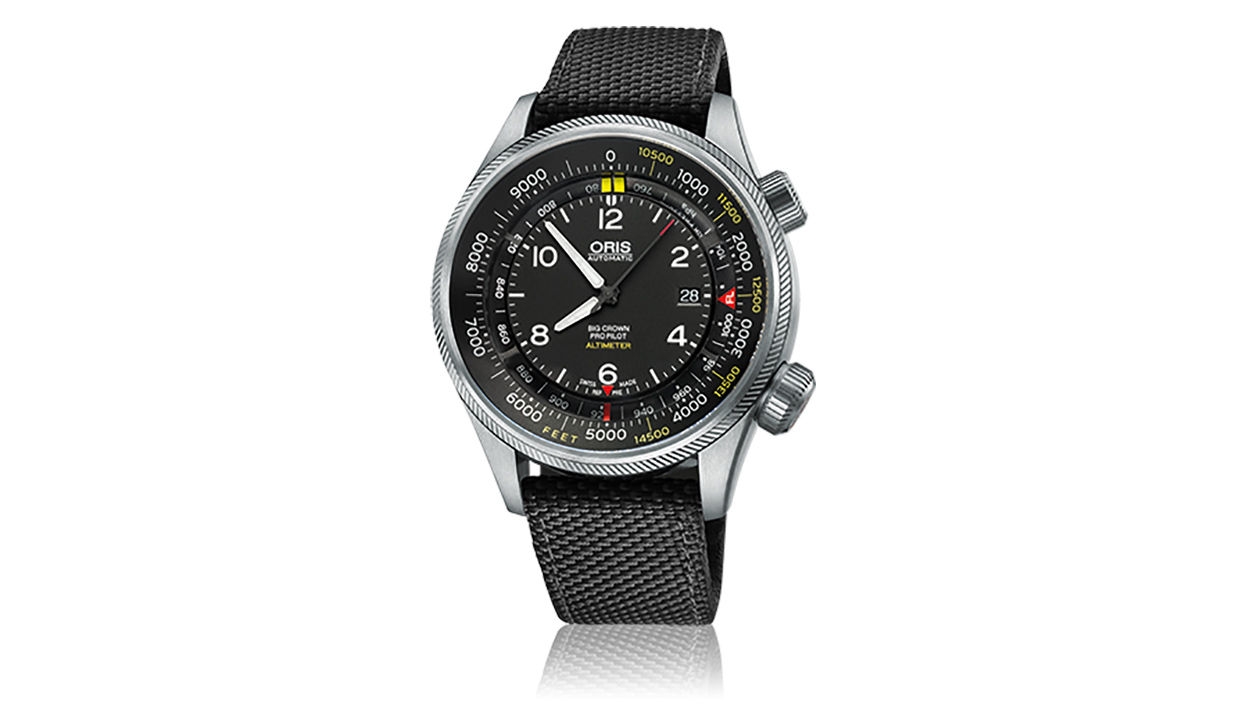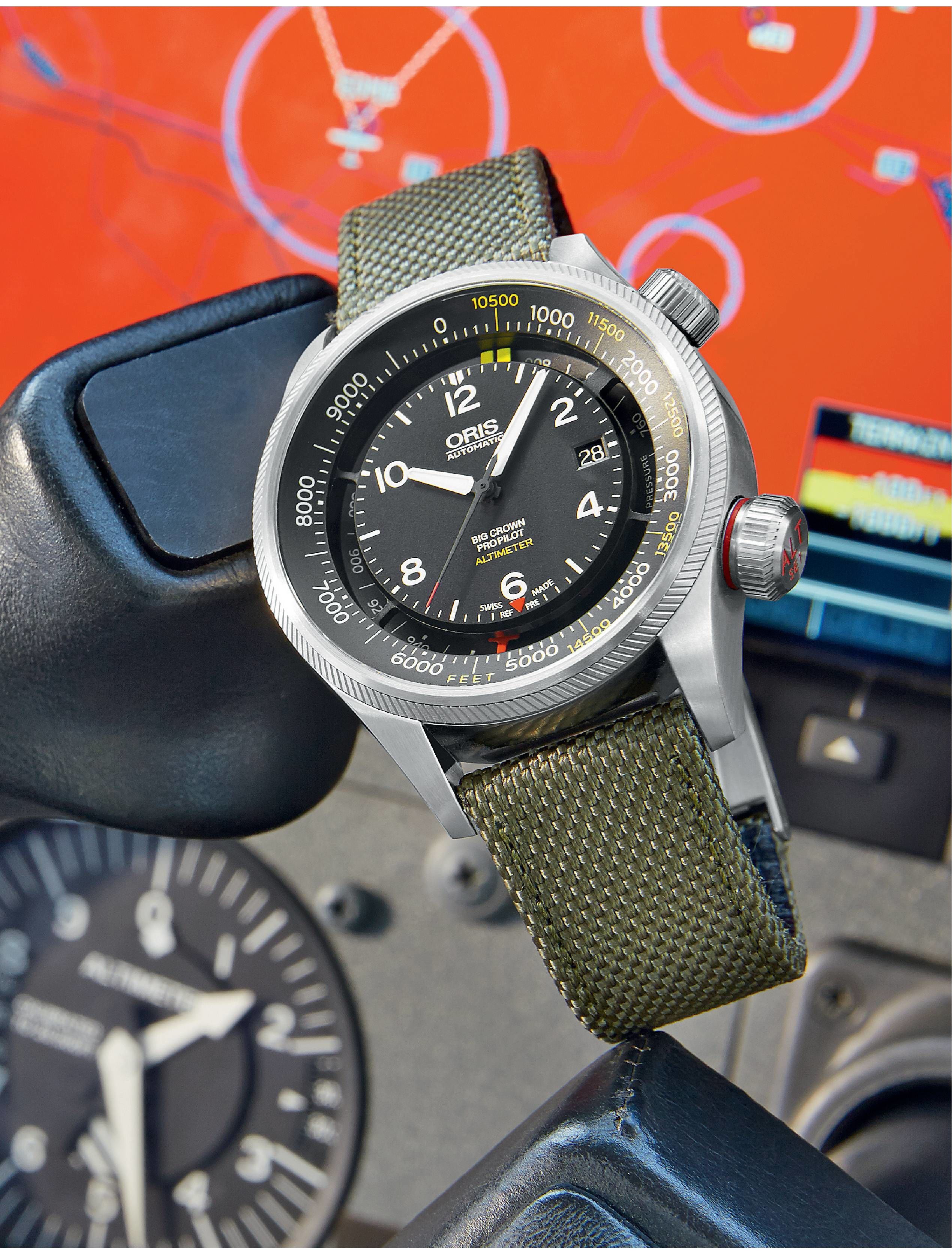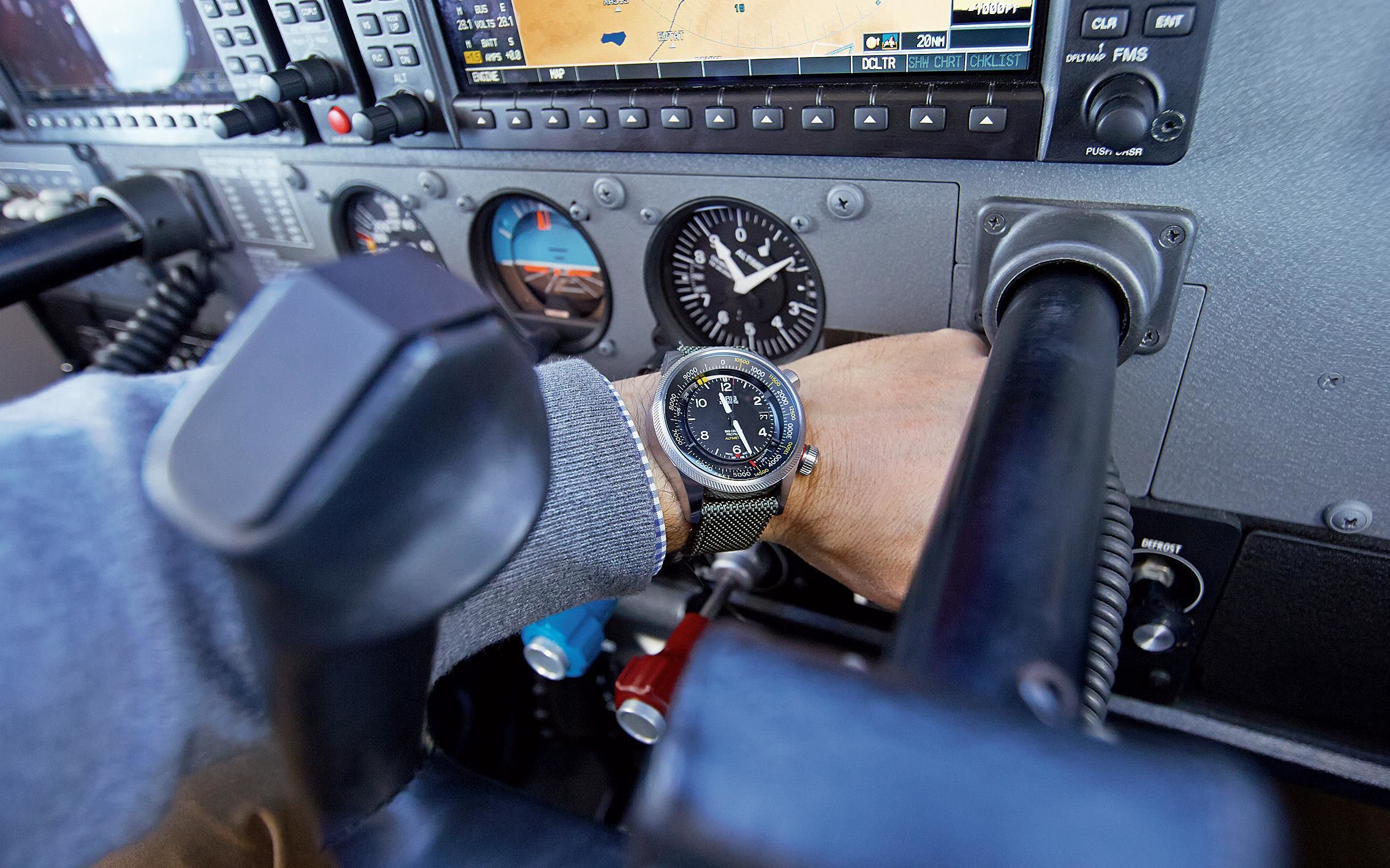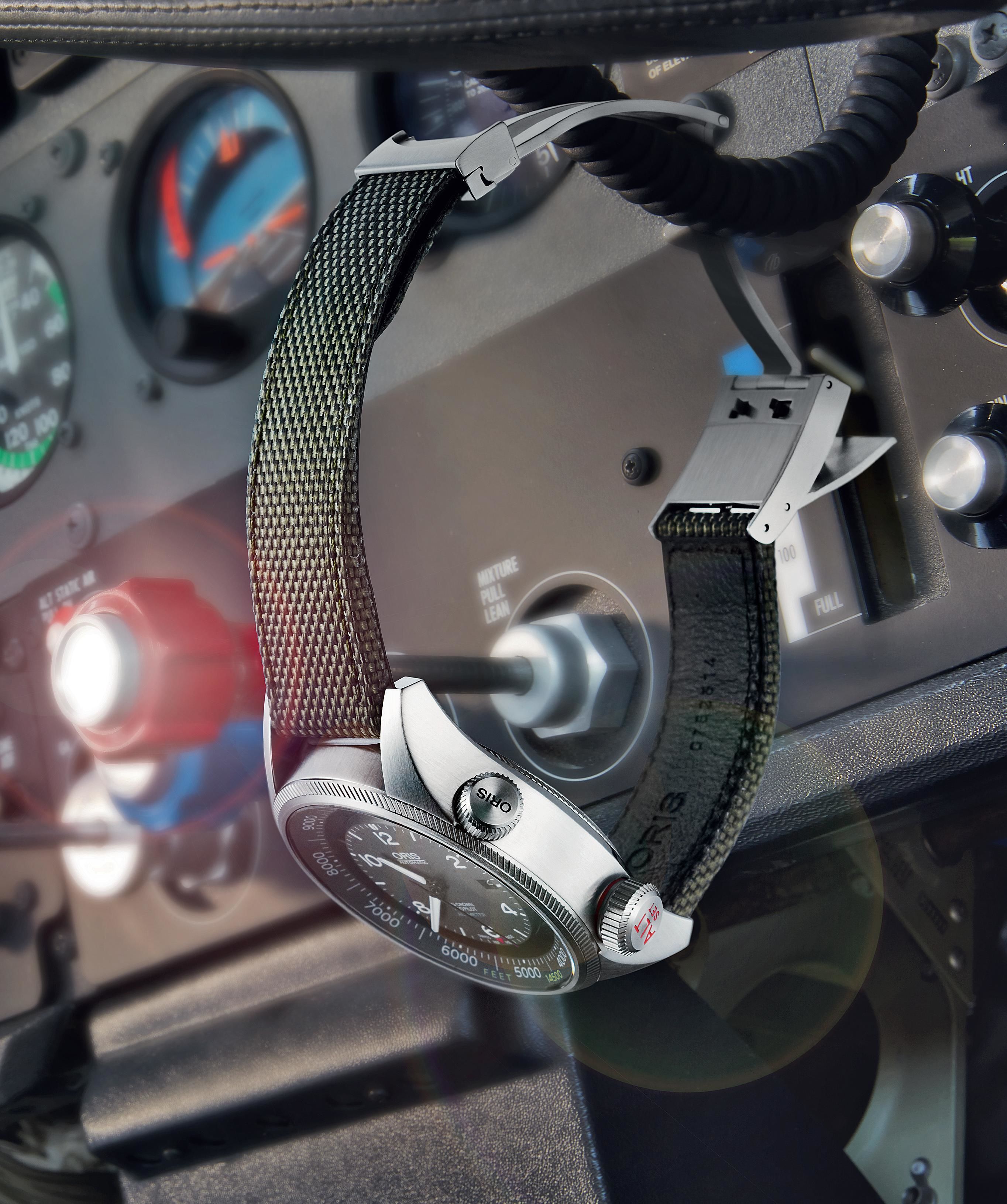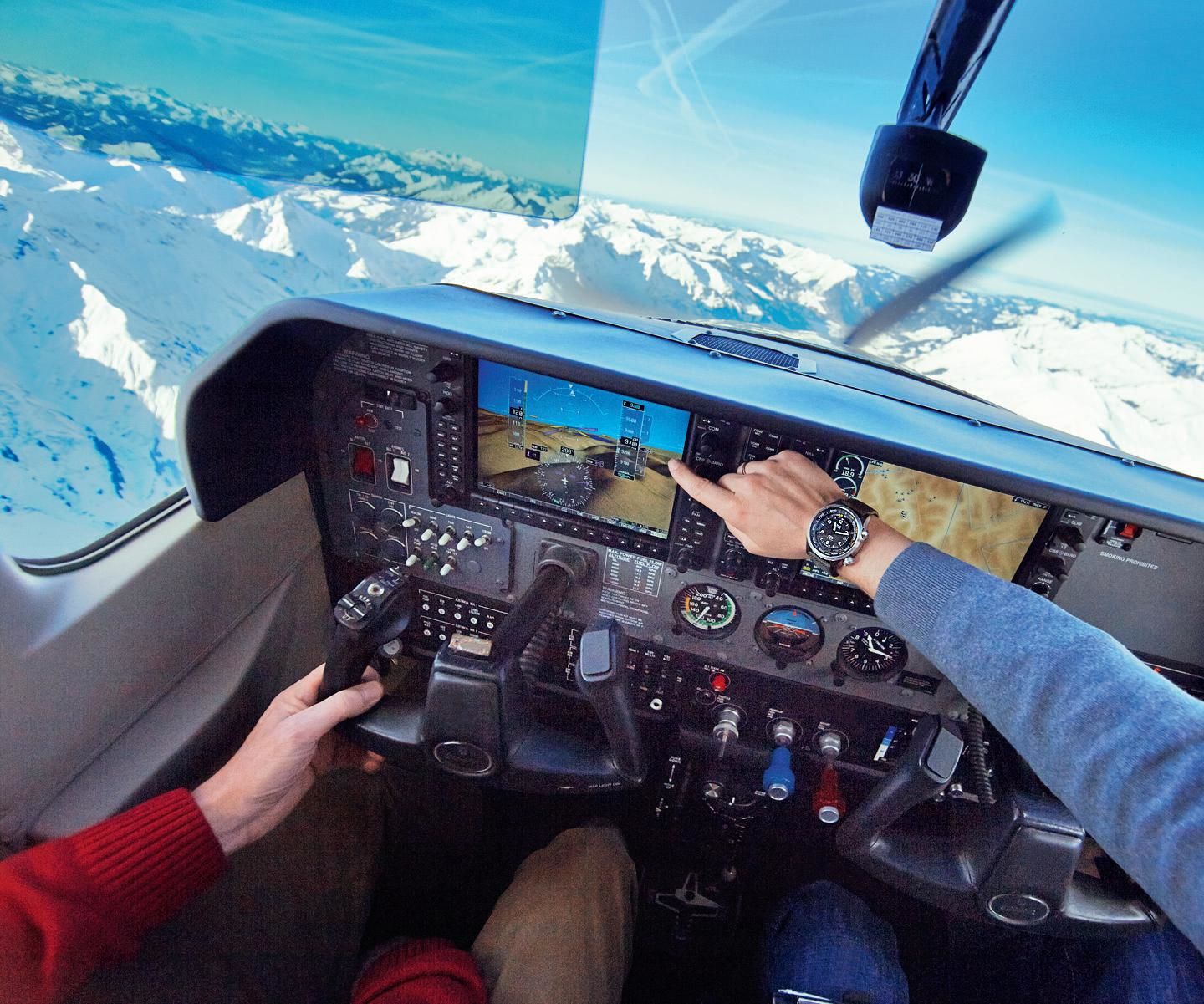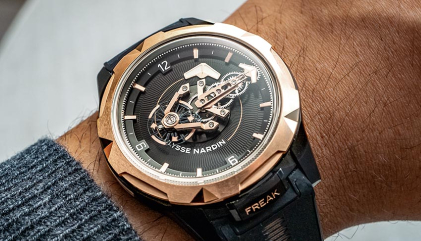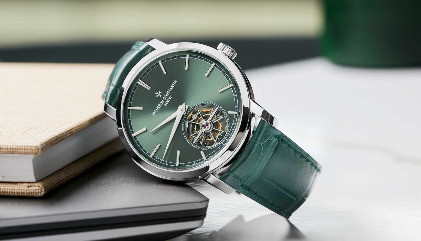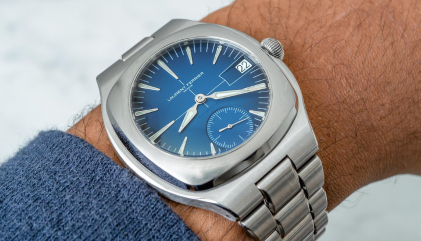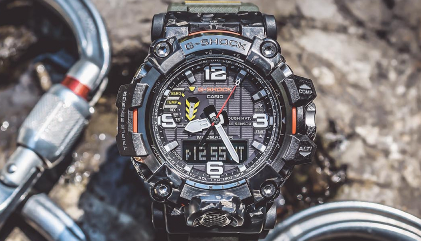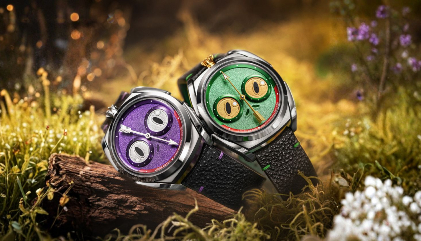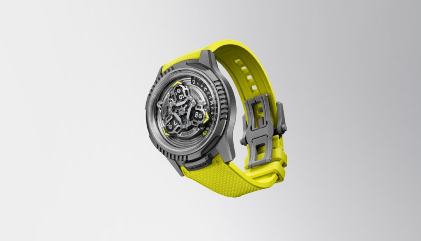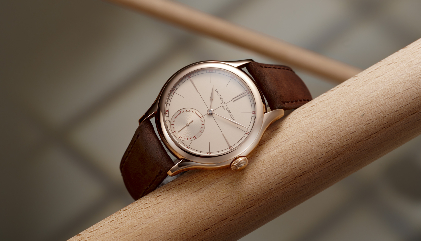It’s late winter and the ground is still frozen when we arrive at the Günzburg, Germany, airport. We’re here to take the Oris Big Crown ProPilot Altimeter, our test watch, for a fl ight in a Cessna 182 four-seater, and we’re glad the grassy runway won’t be too soft to get enough speed for liftoff. The Oris is the world’s fi rst automatic watch with a mechanical altimeter and we want to see how it performs in the air.
Before we prepare our plane for takeoff, we activate the Oris’s altimeter so it can display the correct altitude on its dial. First we unscrew the large crown at 4 o’clock, which allows air to reach the interior of the barometer. The watch’s altimeter works barometrically and the pressure is also dependent on weather conditions, so the crown must be pulled out and the current air pressure set in hectopascals (0.001 bar) at the red triangle at 6 o’clock. When the crown is unscrewed, a red ring becomes visible, reminding us that the watch is no longer water resistant to its stated level of 100 metres. The crown can also be pulled out to a second position to correct the altimeter.
We set the indicator on the dial to the altitude at the beginning of our flight, 1,460 feet. The yellow indicator shows the altitude and the red triangle shows the corresponding air pressure. Then we push the crown back into its closed position and we are ready for takeoff.
We chose the Oris model whose track measurements are shown in feet since that’s the measuring unit used in aviation. This makes it easier to compare the reading on the Oris with the one on the cockpit altimeter. Oris also makes a version of this watch whose track measurements are shown in metres, but it’s better suited for mountain climbers, skiers and other non-pilots. The Oris Big Crown ProPilot Altimeter was introduced in 2014, more than 75 years after Oris made its first pilots’ watch.
We start the plane's engine and roll to our takeoff position. During the pre-fl ight check we verify that the plane’s altimeter corresponds with the altimeter reading on the Oris. Then, at full throttle, we race along the grassy runway. We’re lucky to have a clear day. After takeoff we can see the Alps in the distance.
We climb to 5,000 feet. The Oris altimeter adjusts to the changing altitude more slowly than the altimeter in the cockpit. This is due mainly to the fact that the aneroid capsule in the watch’s altimeter is considerably smaller than the one in the cockpit. Yet both work according to the same principle: a sealed capsule made of thin metal is compressed by air pressure and a lever transfers the changes to an indicator hand. The technology for the watch’s altimeter began with the aviation instrument specialty company Thommen, located in Waldenburg, Switzerland, just a few miles from Oris’s headquarters in Hölstein. You can see the aneroid capsule when you open the watch’s caseback, and the entire altimeter can be removed by loosening the three screws that hold it in place. The automatic movement lies beneath the altimeter, suspended in a ring with four spokes, one of which is thicker to encase the winding stem. The patented design shows the altitude on the outer edge of the dial.
Oris uses another patented design to protect the watch’s movement from moisture when the crown is unscrewed to activate the altimeter: a membrane made of PTFE, similar to GoreTex, has been inserted behind the crown opening. This allows air, but not moisture, to pass through, just like a “breathable” jacket. When the crown is screwed down, the watch is water resistant to 100 metres. The watch’s altimeter hand is also a patented design. It is made of a carbon fiber composite that is extremely lightweight and easy to move yet is shock resistant.
At 5,000 feet, the cockpit altimeter must be calibrated to the standard pressure of 1,013 hectopascals, the average pressure at sea level. This is done for safety, so that all airplanes use the same altitude measuring system in order to avoid in-air collisions. Without this calibration, two airplanes that took off from locations with different air pressures could show different altimeter readings but actually be flying at the same altitude. Above 5,000 feet, pilots no longer refer to altitude but to flight level. Once calibration to the standard pressure is made, 5,000 feet is referred to as flight level 50. The transponder integrated into the airplane can then communicate a comparable altitude to other aircraft so they can either fly around each other or are staggered by air traffic controllers. We also need to calibrate the altimeter on our watch. To do this we line up the red triangle on the lower pressure gauge, clearly marked “FL” (for fl ight level), with the red triangle at 6 o’clock. This design makes it easy to carry out the calibration during our flight in spite of vibration, turbulence and the small size of the gauge.
When the caseback is opened we can see the aneroid capsule for the altimeter.
Now we can see the Alps directly before us. We climb to flight level 105 – 10,500 feet. Bright sunlight gives us a spectacular view of snow-covered peaks that look close enough to touch. The watch’s altimeter shows the same value as the cockpit altimeter in spite of the high altitude. But the track markings on the watch limit the altimeter reading to an accuracy of 100 feet. The altimeter in the cockpit has two hands, like a watch with an hour and a minutes hand, to provide an accurate reading to within 20 feet, so the watch altimeter can’t replace an integrated cockpit altimeter. Practically speaking, though, it’s extremely rare for an altimeter to malfunction. Airplanes that are certified for instrument flight must always have a second altimeter on board. But it can’t hurt to have another backup, even if it is less precise.
The range of altitude the watch can measure is quite high. One rotation of the indicator around the dial shows an altitude of 10,000 feet at the end of the white track. The yellow section of the track represents an additional range extending to 15,000 feet. Most prop planes can’t fly much higher than this without a pressurized cabin.
The large crown at 4 o’clock is used to operate the altimeter.
At this point it’s time for us to turn around and make our way back to the airport. It’s often pretty tight in the cockpit around the controls, especially during visual flight when you’ve got a clipboard with a map and other information strapped to your leg. That’s why it was great to see that the Oris wasn’t a problem to wear despite its oversize diameter of 47 mm. It’s actually quite comfortable. Even its impressive thickness of 17.5 mm doesn’t seem bulky on a slimmer wrist. The textile strap is thick yet flexible and has a leather lining that enhances wearing comfort. The clasp has a fastening mechanism that allows the strap to be adjusted for any wrist, quickly and easily, without damaging the sturdy strap.
The strap is designed to look like an airplane seat belt. The clasp even works like a seat belt and has the instruction “LIFT” engraved on the buckle. And the clasp isn’t bulky, despite its complicated design.
We continue flying over the rolling landscape, which is dusted with snow and dotted with lakes. There are only a few more minutes until we reach the runway – enough time to examine the watch closely.
The Big Crown ProPilot Altimeter has pilots’ watch DNA not only in its name but in its design. The case and dial, like the strap and clasp, are clearly intended for aviators. The entire stainless-steel case has a brushed finish, the bezel has a coin-edge pattern and the abbreviation “ALT SET” (for altimeter setting) is engraved on the altimeter crown and highlighted in red. Both screw-down crowns are easy to grasp and operate. A hack mechanism and quick date adjustment facilitate the precise setting of the time and date. The overall finishing is exceptional with no visible flaws. The design of the matte black dial and the luminous hands match the cockpit instruments and make it extremely easy to read the time.
The cockpit, the Oris and mountains as far as the eye can see
The Oris is powered by the automatic Sellita SW200 calibre, equivalent to the ETA 2824. The Sellita provides an equally sturdy and reliable motor for the watch. Our real-life test on the wrist showed a gain of only 2 seconds per day. Similar results were obtained on the timing machine with an average of +3.8 seconds per day. With values between 0 and +7 seconds, the beat errors showed no great deviation. The amplitude was stable and fell only slightly when changing from the horizontal to the vertical positions. It’s time to begin our descent. Here the watch requires a bit more time to adjust to the new altitude and lags behind the cockpit instrument reading by 500 feet, but it shows the correct values only a few seconds after leveling out. This slight delay in response time makes it unsuitable for skydivers.
Flying is an expensive pastime; the price of the Oris is rather modest in comparison: `2.4 lakh (approx.) for the watch with its sophisticated altimeter is almost shockingly low. The entry-level watch in the Oris collection of pilots’ watches, the Big Crown ProPilot Date, is also a very affordable `99,200 (approx.). It’s just another `1.4 lakh (approx.) to add the altimeter and an additional 6 mm to the watch’s diameter. The result is a unique pilots’ watch – no one else combines a mechanical altimeter with an automatic movement. Breva added a mechanical altimeter to a hand-wound movement in its Génie 02 Air, but at a price of `84.4 lakh (approx.). We approach the airport and announce ourselves via radio. The tower warns us of a fl ock of birds on the runway. We’ll see whose runway it is in a minute! The crows flap off and we land safely at the point of our takeoff. We’re left with the memories of a great flight and a well-designed pilots’ watch with a complication for aviators.
SPECIFICATIONS
Manufacturer: Oris SA, Ribigasse 1, CH-4434 Hölstein, Switzerland Reference number: 733 7705 4134
Functions: Hour, minutes, seconds, date, altimeter
Movement: Sellita SW200, automatic, 28,800 vph, 26 jewels, hack mechanism,
quick date adjustment, Incabloc shock absorber, eccentric fine regulator, Glucydur balance, 38-hour power reserve, diameter = 26 mm, height = 4.6 mm
Case: Stainless steel, curved sapphire crystal with nonreflective treatment on the inside, fully threaded stainless-steel caseback, water resistant to 100 m
Strap and clasp: Textile strap with stainless-steel folding clasp
Rate results:
Deviations in seconds per 24 hours
Dial up +6
Dial down +3
Crown up +5
Crown down +2
Crown left 0
Crown right +7
Greatest deviation of rate 7
Average deviation +3.8
Average amplitude:
Flat positions 289°
Hanging positions 269°
Dimensions: Diameter = 47 mm, height= 17.5 mm, weight = 172 g
Variations: With metric track; with stainless-steel bracelet `2.6 lakh (approx.)
Price: `2.4 lakh (approx.)
SCORES
Strap and clasp (max. 10 points): The strap and clasp are designed to mimic an airplane seat belt and are also practical, attractive, nicely finished and easy to adjust. 9
Operation (5): Both crowns are easy to unscrew, pull and turn; with hack mechanism and quick date adjustment 5
Case (10): Brushed finish on steel case with curved sapphire crystal is nicely executed; Oris provides an innovative solution using a special membrane to protect against moisture when the big crown is unscrewed. 9
Design (15): Attractive and technical pilots’ watch design 13
Legibility (5): The Super-LumiNovacoated hands showing the time are easy to read, as is the date. The track markings limit the altimeter reading to an accuracy of 100 feet. 4
Wearing comfort (10): The Oris is comfortable to wear despite its large size and thickness. 9
Movement (20): The sturdy, automatic Sellita SW200 is equivalent to the well-known ETA 2824 and is a reliable power source. 10
Rate results (10): Only low average deviation on the wrist, and stable amplitude. The values in the various positions could have been a little closer. 7
Overall value (15): A low price for a watch with a unique and practical added function that was difficult to integrate 14
TOTAL: 80 POINTS





